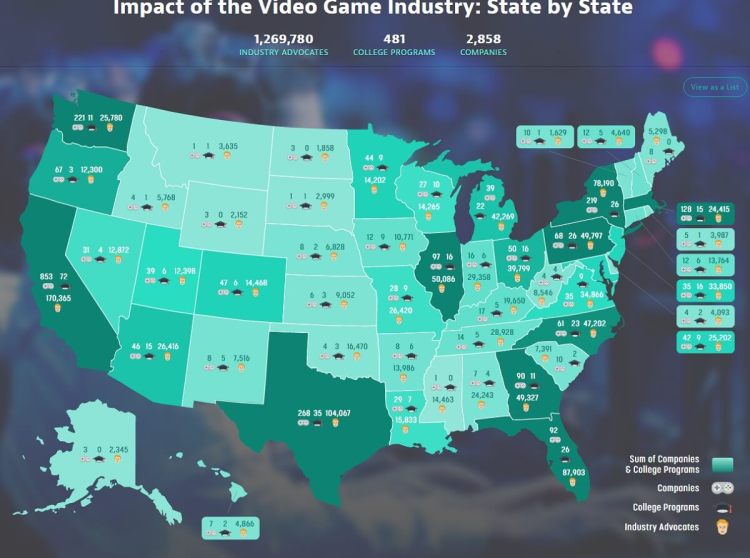Figuring out how many game jobs there are in the world is a laudable goal. But it’s easier said that done.
I embarked on this task a while ago as part of a quest to figure out which regions of the world are most competitive when it comes to making and publishing games. PC and console games once ruled, and it wasn’t as easy to figure out which regions were strong: Japan, the U.S., and parts of Europe.
But the iPhone changed that starting in 2008, when the app store opened. And now mobile is the biggest part of the industry, with $40 billion in revenues, according to SuperData Research. That caused an explosion of new indie game companies and it changed the lives of many indie developers.
I’ve collected data for this story with special independent research provided from job posting site Indeed.com and market researcher SuperData Research. I gave a talk on this subject at Casual Connect Europe, the big game event in Berlin last week. Here’s an edited transcript of the talk, and the slides are here. Here’s the video version of the talk. I have since added additional details in the text below. –Dean
Much of that growth was serendipitous. But can regions influence that economic growth for their own reasons? Theoretically, you can design policies to make that growth happen deliberately. That’s what this story is about.
But in some ways, this is an unfinished presentation. It’s not because I didn’t know how to use PowerPoint, but more because there isn’t really a simple answer to the problem I was looking at. How do you create jobs? How do you grow your region when it comes to the game industry?
I tried to dig out some data, but I’m not done. What I’d like to have one of these days, from someone like maybe Nick Berry of Facebook here, is a real-time picture of the world that shows all the jobs, companies, and revenues in the game industry in a visualized map of the world. Nobody has that yet. As far as I’ve been able to dig up, looking for this data, it doesn’t exist. If somebody does it, maybe they could collect it once a year, or once every five years, or on a particular country. But it’s hard to find.
I gave a series of talks in Japan about this as well. We’re going to do some more updating along the way. On the third bullet point here, we have our GamesBeat summit in May in Berkeley, and our GamesBeat 2017 conference in October. This is a topic we’ll go into, and also into the inspiration cycle between science fiction, technology, and games. That cycle, to me, is one of the explanations for how and why you can create games in a particular region. Silicon Valley has all of those things, and it has helped. Los Angeles has all of that in Hollywood. These are models to follow.
The gaming world is flat
I’ve been lucky enough to travel around the world. This is my fourth trip to Berlin. I believe Berlin’s tolerance and openness to immigrants will become one of its fundamental advantages in attracting game talent. These trips to different game hubs around the world have taught me that when it comes to jobs in the game industry and designing great games, the world is flat.

Above: Floating in the Dead Sea.
I stole that line from Thomas Friedman, the New York Times columnist, the author of The World is Flat. He also traveled the world, and figured out that the Internet, computing technology, and smartphones have equalized the playing field for competition. New technology can be created pretty much anywhere now. The Dead Sea is one of the places I went, doing research for this particular speech.

Above: The Last of Us featured a deep, evolving relationship between Ellie and Joel.
The Last of Us is my favorite game of all time, and I feel like it could only have been made in Los Angeles. It is a cinematic experience and finely crafted, with talent born from a studio that has been around for decades and access to the best of screenwriters.

Above: Alexey Ushnisky (left) , CEO of MyTona, and his twin brother Afanasiy Ushnisky, chief operating officer.
But you can make a game anywhere. These two Siberian brothers I met at Casual Connect Tel Aviv, they grew up in the cold. They couldn’t go outside and play, so they played indoors, and naturally they gravitated to video games. They taught themselves how to make video games, and by the 15th game their company, MyTona, had a hit. This hidden object game had more than 30 million downloads. Eventually they had 100 people working for them in Siberia. So maybe one of the ingredients for creating a talented game work force is to have a cold climate.
When mobile came along, it equalized the playing field. Before that, PC and console gaming were very concentrated in parts of the world like Japan, the U.S., and the United Kingdom.
But some regions stay strong
But again, these regions keep coming back as the strongest in a lot of ways, across all of the industry. Can you duplicate that? Can you grow that from scratch? I don’t know. Sometimes it takes decades to grow your talent or specialty within games.

Above: Taiko drummer game in a Tokyo arcade, or “game center,” operated by Taito. It’s called Taiko no Tatsujin, or Taiko Drum Master.
Japan still has hundreds of arcades spread around its cities, and its people are inculcated with a strong gaming culture. The U.S. doesn’t have arcades anymore. The Japanese can use arcades as experimental locations for new games and new technologies. Virtual reality experiences are debuting in these arcades, already in place. In the U.S. we’re just talking about how we should maybe bring arcades back. Maybe it was a bad idea to lose them after all.

Above: Strong game regions got their start early.
It’s interesting to me that Atari and the first games came out of a region that had decades of computing platform experience behind it. Atari was born in Silicon Valley, and that was no accident. But each of these events listed here is a beginning point in time for a whole regional economy, built around games. It wasn’t Nokia that gave birth to Helsinki’s mobile industry. It was the Demo Scene and hacker groups that started quite a long time before. If your region’s not here, that just means you’ve had less time to develop your game industry.
The ingredients for a strong region
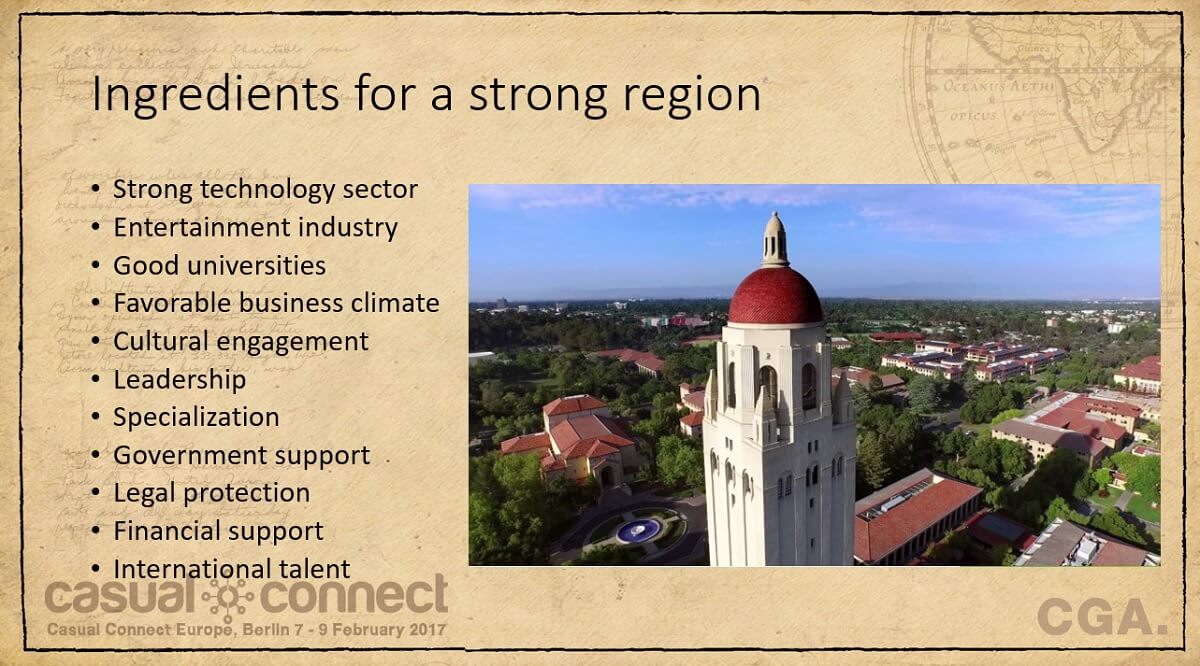
Above: Silicon Valley’s strengths
If you have a chamber of commerce sort of person, or regional development people who want to attract game companies to your region, this is the kind of slide you’d have. This is how you can make good things happen. Silicon Valley wouldn’t be there without Stanford University.
It’s instructive to follow some history here. Silicon Valley beat out Boston as the place where the computing industry would be. Boston was good at making mini-computers. It was a vertically integrated computing town. When the PC came along, it became a horizontal industry. Microsoft made the operating system. Intel made processors. PC companies like Compaq made hardware. Other companies made applications. That proved to be a very flexible ecosystem. Businesses could move faster in that environment.

Above: Regional Advantage by Annalee Saxenian studied the rise of Silicon Valley over Boston.
So Boston lost and Silicon Valley won. AnnaLee Saxenian wrote the book Regional Advantage that captured this story. It was a platform change that caused one region to die and one region to rise. The San Francisco Bay area is strong in games not only because there’s a tradition of game-making there, but because the platform owners are there. Oculus, Facebook, Google, Apple, Intel. Microsoft isn’t far away, in Seattle. That helps explain why the region is strong. There are a lot of game jobs in those companies, although they aren’t directly counted as game jobs.
The vertical versus horizontal competition is still playing out, and in some ways, they are counters to each other. Disney has shifted to a licensing model, where it is partnering with outside game studios to make games. Warner Bros., by contrast, has acquired or grown eight major game studios to make its own games. Warner hired many of the people at Avalanche Software, the studio that Disney shut down when it exited the Infinity toy-game business.
What is interesting about the toys-to-life business that Activision Blizzard created with Skylanders is that it has created some huge barriers to entry. If you want to participate in that business, you have to be able to create a line of toys, and make games that run on just about every platform. You have to make the portal-like hardware to digitize the toys, and you can also make TV shows or movies based on the characters. In other words, to participate in toys-to-life, you have to create a whole business ecosystem. Disney had this with Infinity, where it could sell the toys and games in its Disney Stores, and build the toys and games based on its movie characters. Activision has entered the TV show and movie business, as well as 3D printing of toys, to advance its Skylanders ecosystem.

Above: Global game sales
Where the game companies and jobs are

Above: The U.S. game industry stats
Here’s how the world looks as far as where global sales are. It’s worth noting that China, of course, is the biggest market for games now. We had some speakers earlier noting that mobile games are the biggest part of the industry now. SuperData Research’s data shows mobile games have hit $40 billion in 2016. Having strong regional game sales gives you an advantage, particularly if there are significant barriers to entry for foreign game companies to enter a market, like China.
SuperData created a series of slides for me on the numbers of game companies around the world. This is brand new data. There are 2,900 game companies in the U.S., 472 in Canada, 350 in Argentina, 880 in Brazil. These numbers show how strong the regions are relative to each other, but the number of companies isn’t the only metric that matters. The number of jobs is also important. I’ll expand on that point later.
The Entertainment Software Association, the game industry trade group in the U.S., collected some data they published a few years back. They counted 1,641 companies and 150,000 jobs directly related to games. Today, the ESA said there are now 220,000 jobs in games in the U.S. Of those, 65,678 jobs are direct jobs, while the rest are indirect. The number of companies is now 2,457.

Above: Asia’s game companies
Here’s the SuperData data for Asia above. It’s pretty stunning to learn that 6,111 companies are in China. I thought it was just my imagination, or I was just really ill-informed, but when I went to China, to the China Joy show, I would talk to these game companies. I’d ask them how many employees they had and they’d say something like, “Oh, we have 1,000.”
And I’d never heard of this game company before. I don’t know how many of these companies have that many people, but it wouldn’t surprise me if it’s a lot. The numbers kind of lie, though, because Japan is so strong in games and game companies. If you want any game company in your region, you want Sony or Nintendo. Each of these companies counts as just one company.

Above: Game companies in Europe.
Europe’s game jobs
Here’s some data on Europe’s game companies above, and the slide below has Europe’s game jobs data as well. The data for France is interesting, as Ubisoft skews the number of jobs higher. The international game giant has 10,000 employees across the whole company, but France as a whole is relatively small for such a large country.

Above: Europe’s game industry stats.
Spain has come on strong, with 480 companies and 4,460 employees. Germany has 450 game companies with 30,231 employees across all types of companies (other reports list smaller numbers). Sweden has 236 companies with 3,709 employees. Finland has 290 companies with 2,700 employees. France says it has 300 game companies and 5,000 direct jobs, though the latter sounds low. The United Kingdom has 2,088 companies and 12,000 employees. The Netherlands has 455 companies and 3,030 employees. Italy has 120 game companies, with 700 to 1,000 game jobs. Romania has around 60 companies and more than 6,000 employees. New Zealand has 600 employees. Iceland has 20 companies and 500 employees. Norway has 60 companies and 490 employees. Denmark has 190 companies and 720 employees. Sweden has 250 companies and 3,700 employees.
The British Council did a report in 2013 that referenced additional job numbers in Poland (200 to 300 companies and 2,000 employees), South Korea (957 companies and 95,051 employees), and Brazil (133 companies with an average of 8.5 employees each).
Finland stands out as one of the best examples of government support for the game industry. Tekes, the government funding agency, offers loans and grants for research and development work carried out by companies. Tekes pours hundreds of millions of dollars every year into hundreds of tech startups.
One of its best bets ever was investing €5 million into Helsinki-based Supercell, which went on to make the games Hay Day, Clash of Clans, Boom Beach, and Clash Royale. Supercell has only about 250 employees, but it generates well over $1 billion a year in revenues. And each year, it pays several hundred million euros a year in taxes. That’s a huge return for Finland. And Supercell itself was valued at $10 billion when Tencent bought majority control of the company in 2016.
Revenues in the Finnish game industry exceeded 2 billion euros in 2015, and game companies raised 80 million euros in Finland, from 2012 to 2015. Finnish corporate taxes have also fallen from 26 percent in 2011 to 20 percent in 2016.
Other countries have also helped their game startups in other ways. Estonia has an accelerator, GameFounders, which has been training game startups since 2012. The program worked so well at training game companies from around the world that GameFounders opened a branch in Malaysia. Sweden also has an accelerator, dubbed Stugan, out in the woods, where game developers get three months of training from industry veterans.

Above: The top countries in the world for game job postings.
The top regions for game job postings
This is also brand-new data from a job posting company called Indeed.com. A while ago they produced an interesting data point about the U.S. Since 2014, the number of job postings for games in the U.S. has gone down 65 percent, according to the postings counted by Indeed.com. I asked them to do a map of the world when it comes to job postings, and they actually crunched all the data and came up with this. South Korea has the most jobs posted in the game industry now.
Indeed.com did an interesting calculation in the fall of where the job postings are in the U.S. So it was able to come up with this list, which shows that around 24 percent of the jobs posted in the U.S. are in the San Francisco Bay Area. The Bay Area has about twice the number of game jobs as Los Angeles. Perhaps the key to understanding what is happening in the U.S. is understanding what is happening in some of its biggest cities. Dallas, which has been strong in first-person shooters, doesn’t show up on the list, while Reno, a hub for online gambling, does show up on the list.

Above: The top cities for game jobs in the U.S.
The U.S. is in tenth place, according to Indeed.com’s survey of the world’s game job postings. That makes me wonder what’s going wrong in the U.S. Where are those jobs going when it comes to the game industry? On the one hand, the U.S. has become too expensive to make games. On the other hand, it is the hub for new kinds of jobs, like virtual reality. The virtual reality category grew job postings 400 percent in a couple of years, while esports jobs are up 40 percent.
Spain is very high on the list. The acquisition of Social Point, based in Spain, puts the region on the map. Take-Two Interactive acquired Social Point for at least $250 million. In some ways, acquisitions can hurt a game region because it takes the decision-making power and moves it away from that region. That’s usually not good for employment at that company in the region. On the other hand, acquisitions create wealth in a region, and that can lead to new game startups.
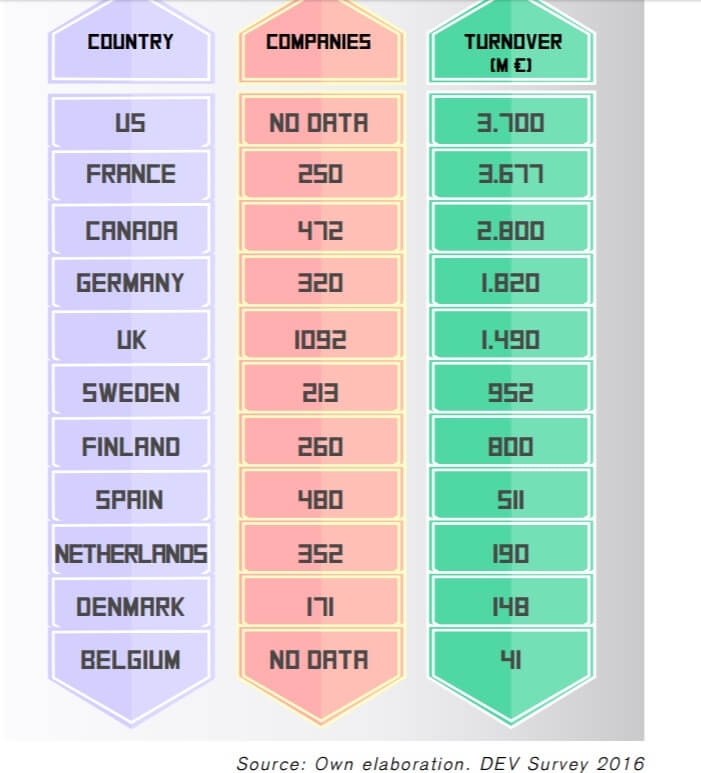
Above: Game stats by country.
Canada’s strength as a U.S. satellite
Canada’s strategy as a companion region to the U.S. is working well. You can have your headquarters in the U.S., but since it’s so expensive to hire developers in the U.S., you can set up shop in Canada instead and hire two or even four engineers for the price of one compared to Silicon Valley. All told, Canada has 20,400 game employees at 472 companies.
The presence of negative influences, like Donald Trump’s anti-immigrant point of view, can also cause the jobs in the U.S. to dissipate. Trump’s immigration ban and his desire to build a wall to keep out terrorists will also keep out talented game creators.
High costs and the lack of government subsidies or incentives make the U.S. more costly compared to regions where governments off that. Canada pours $4 billion a year in subsidies into its industries, including games. And it has attractive tax breaks that make the cost per employee about 25 percent of the U.S.
Canada, however, can’t beat the U.S. in sheer population. To some perspective on the comparison, the state of Washington alone has 423 game companies with 20,800 employees.
Game industries can’t be taken for granted. Sometimes they fizzle, due to war, layoffs, or acquisitions.

Above: Reasons why a game region can fizzle.
I heard from Nvidia’s CEO there are about 1,500 startups in artificial intelligence right now. Those suck a lot of jobs out of game companies in Silicon Valley. Some AI engineers in Silicon Valley are getting salaries around $1 million a year, according to our AI reporter Jordan Novet. It’s the hottest new thing. The presence of competing industries next to the game industry can make the game industry look really bad in the U.S. It can pull jobs out of the game industry because there’s something better down the street.

Above: Reducing your game region’s risks.
But governments don’t have to be helpless. There are things you can do to reduce the region’s risk of losing its game industry. I’ve listed some of those ideas above.

Above: The top cities in the world for game job postings.
Top game job postings by city
This was another interesting chart from Indeed.com, where the number one city in the world – where you should all move right now – is Seongnam, South Korea. They have the most jobs posted out of any city in the world. Again, looking at where San Francisco is, it’s number 13 on the list. Bellevue, Washington has more jobs open than Silicon Valley. But again, this makes me ask more questions. Why is this? I’d ask the whole game industry to help us figure out the answers.

Above: The top 10 public game companies.
It was eye-opening to see who the largest public game companies are. Tencent, from China, is the largest game company in the world. This is what I like about the games business. Everything is weird and unpredictable. Supercell, with 250 employees now, is valued at $10 billion, based on a real transaction. It’s worth more than Ubisoft, with 10,000 employees, valued at $3.7 billion. Ubisoft maybe isn’t as capital efficient as they might hope.
A lot of the strongest leaders in the game industry are platform owners. Mixi got on the list on the strength of a single mobile game. In the first half of 2016 we saw a little bit of change, but not much.
Where the jobs will be
As I mentioned before, if there’s a reason to change the order of things in the world, new platforms are the way to do it. To invest heavily, to dive into new regions, platforms are the way to create new jobs. The new platforms that could create more jobs in the future include VR, AR, esports, toys to life, and TV.
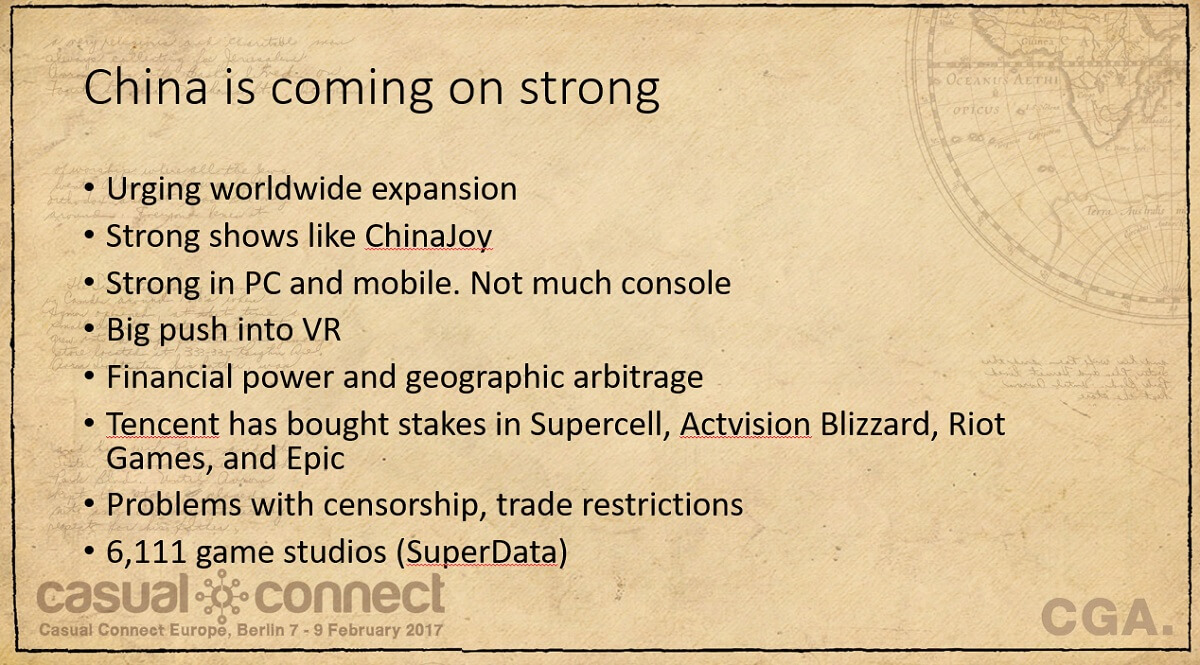
Above: China’s regional strength in games.
China is strong, but ultimately you run into the problem of government censorship. It’s not necessarily the best place in the world for creative professionals. China is strong in mobile and PC games, but not so much in console. It is making a huge push into VR via its Internet cafes. Tencent has bought stakes in Supercell, Activision Blizzard, Riot Games, Miniclip, Epic, and Glu Mobile.
Israel has a very interesting history. It started in online gambling, but that expertise served them very well with the rise of social casino games. The largest social casino game maker, Playtika, grew to well over 1,000 employees, and was then acquired by a Chinese company for $4 billion.
M&A activity can have a very big effect on what happens to your region and where the strength of the game economy is. If someone from another region acquires a company, they have different interests than necessarily keeping jobs in your city or your country.
85 percent of Spain’s 480 companies didn’t exist 10 years ago. With that number, it’s not a surprise that they recently had a big exit with Social Point getting acquired by Take-Two Interactive for more than $250 million.
Things can change. In Israel and Ukraine, we found out that geopolitics can matter. When countries go to war, that’s not good for the game industry. We all learned that playing Civilization. If you go to war, it’s rarely good for your empire. Austin had a vulnerability in that it was especially dependent on the MMO industry. They had lots of MMO companies, and when the smaller MMOs were all killed off by World of Warcraft, those companies disappeared.
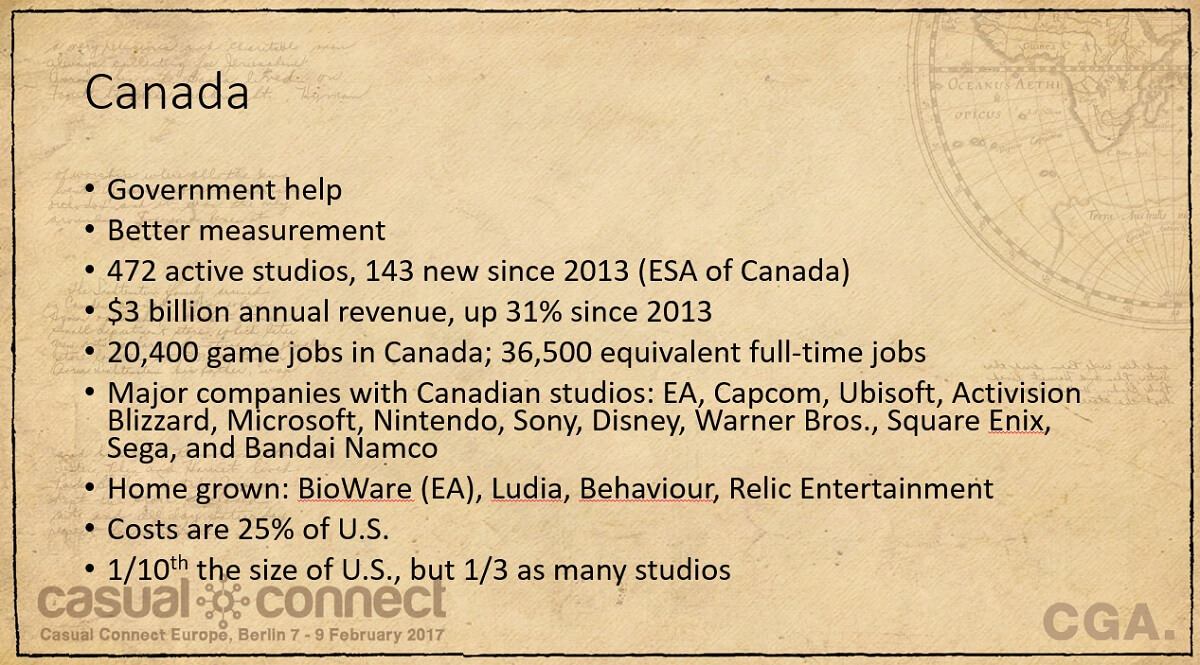
Above: Canada’s advantages in games.
Immigration policy in the U.S. is not going to give the industry an advantage over the next four years. Canada is strategizing right now with regard to taking advantage of Donald Trump, and they’ll probably have a lot of success. The game industry should welcome people and welcome games. We’ve seen governments obsess over violence in games, how to regulate games, how to keep them out of the hands of children. We see some regions where people grow up playing games and some regions where they don’t. India didn’t have a history of people playing games, and they’re not as far up the food chain in the industry today.
The idea of a food chain is appropriate as far as how countries and regions can strategize about how to grow in the future, how to move up. You can start with game testing at the very bottom. At the top of the chain, I guess, is Grand Theft Auto, or something along those lines. Your industry should level up, just as game developers level up, to stay ahead of a commodity war at the bottom of the food chain.
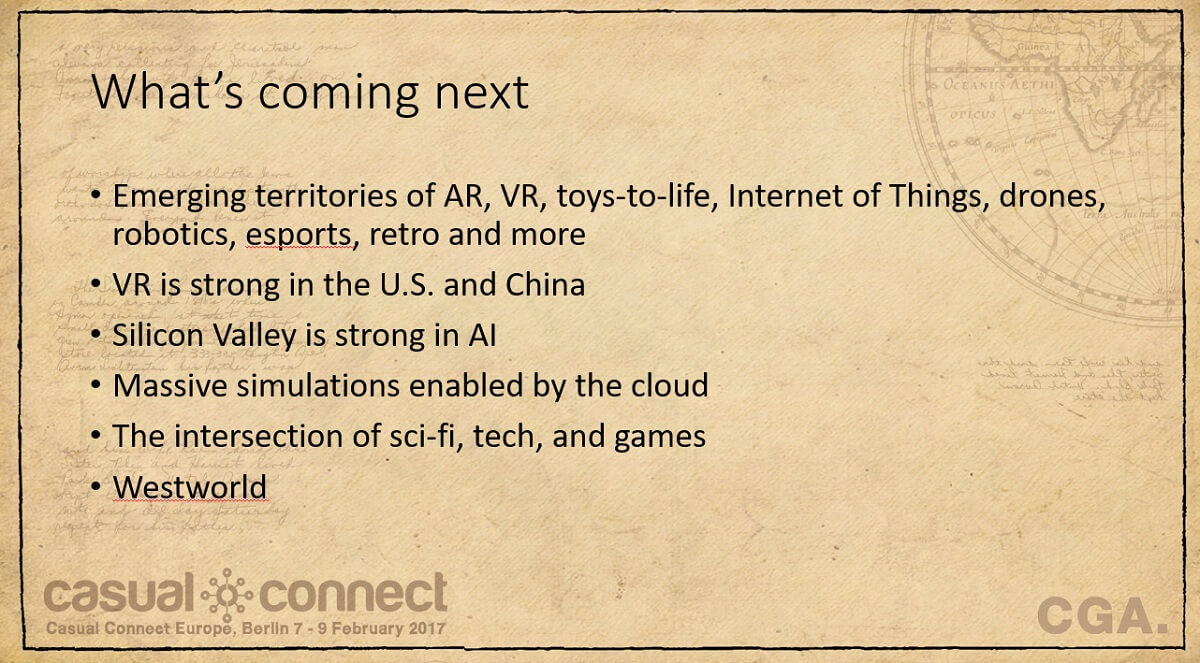
Above: What’s coming next for games?
Emerging regions
What’s coming next? I do think AI is moving along fast. It’s going to create lots of impact in the game industry. Our GamesBeat Summit 2017 event is about the inspiration cycle between real-world technology like AI, science fiction, and video games. The proximity of all those AI people to Silicon Valley will turn into an advantage. It’s an advantage for Canada as well.
When I was counting companies, the map of the world might look something like this, which is interesting. Here are some new regions. It was interesting to find in the course of this research that Iran has 150 game companies with 2,500 developers. Lithuania has 30 companies and 200 employees. I’d love for somebody to go around and count all this so I don’t have to, and then visualize them for me on a map.
What really matters are franchises
If you think of all your favorite characters around the game industry, put them on the globe, and stick them in the places where they were created, you get something that I think really matters. You have to create franchises that last for generations, like Disney or Nintendo. When you create something like that, it has a lasting effect. It creates thousands of jobs, which is ultimately what you want to get to.
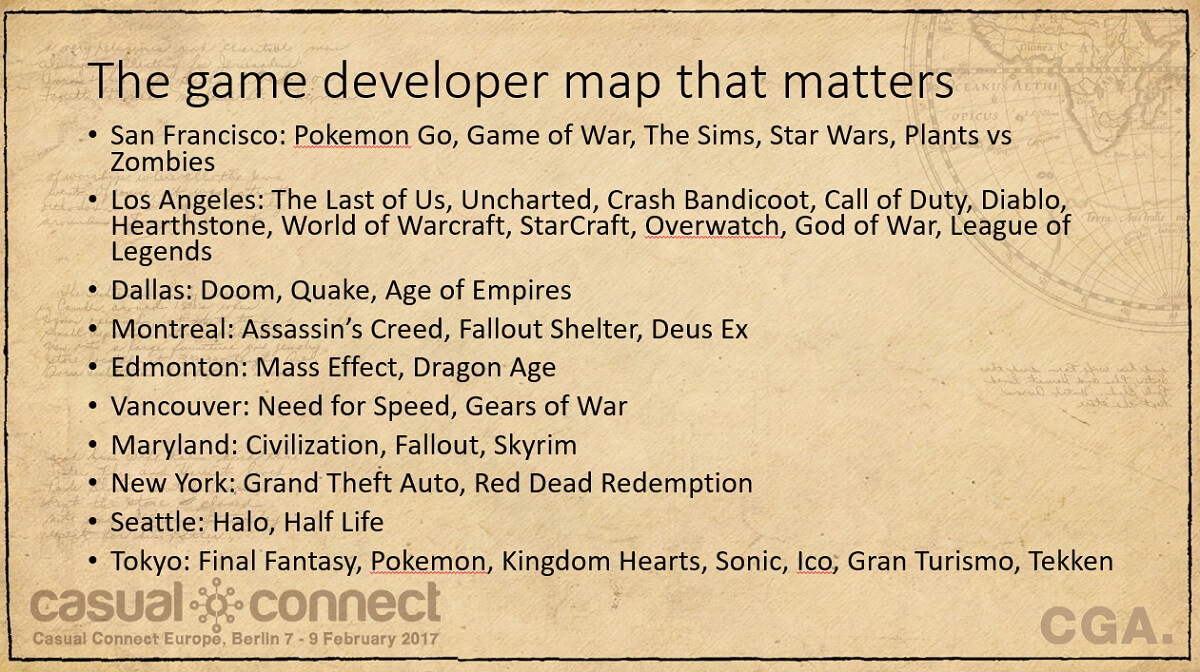
Above: Top game franchises by region.
Los Angeles is doing pretty well. It has a good share of all the great franchises in the gaming world, and it can exploit Hollywood talent. It has huge companies like Disney and Warner Bros. that can consolidate talent and intellectual property. If someone took this and counted all the revenues generated by these games, you’d have another interesting answer as to who has the strongest game industry. There are all kinds of interesting ways to create a scorecard that could make your region look good. Moscow and Honolulu – that’s Tetris.

Above: Top game franchises by region, part 2.
Conclusions
As I say, this work isn’t done, but it’s an interesting question to ask. Where are games now? Where are game jobs? Where are they going to be? You can’t just think about building a company. You have to think of building your region. When you think about your region, you can’t just count the number of jobs or the number of game companies. You have to look at whether you have franchises in the making that are going to last for generations.
Cost isn’t the only advantage. You can create a hub that includes a lot more than just games. Silicon Valley has everything tech. Los Angeles has Hollywood and entertainment. All of those things are important. Government support can be wonderful. Incubators can generate lots of startups.
The support network for game companies doesn’t really exist across the entire nation in the U.S. Maybe that helps explain why the number of jobs in the U.S. is going down, because there is no strategy for the country to hold on to its jobs. Taking that for granted in any region is a shame.
If you start doing some of these things, your region can help games take over the world. That’s my conclusion so far. Thank you.
Disclosure: Casual Connect paid my way to Berlin. Our coverage remains objective.
